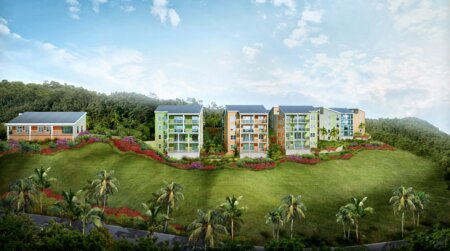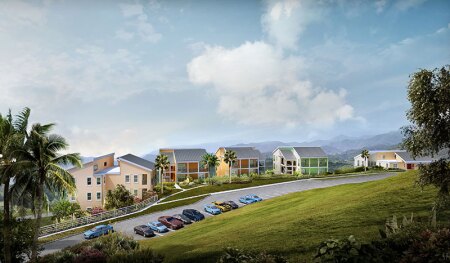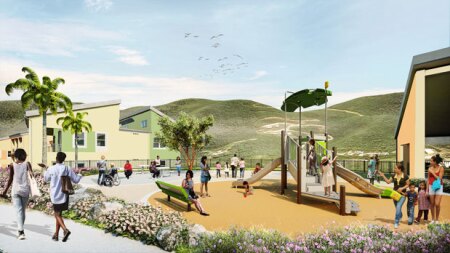After a pair of hurricanes pummeled the Virgin Islands’ aging public housing in 2017, a public/private partnership used advice from ULI panels to develop a resilient, sustainable replacement that promises to raise residents’ living standards.
When two Category 5 hurricanes, Irma and Maria, hit the U.S. Virgin Islands in quick succession in 2017, the public housing sector in the territory—which accounts for 15 percent of its total housing stock—suffered some of the most severe damage. On St. Thomas, the Tutu High Rise complex was battered by winds that ripped exterior walls off buildings, leaving the apartments and their low-income residents exposed to the open air.The catastrophe exposed an underlying problem as well. Buildings for low-income residents, which had been erected decades ago to meet minimum standards of quality, had suffered through decades of punishment from extreme weather, even before the recent hurricanes rendered some uninhabitable. Simply maintaining the outdated developments would not offer protection against the increasingly extreme storms that climate change is likely to bring in the future, or adequately provide for the residents’ needs.“We’re never, ever going to build housing the way it was allowed in the ’50s, ’60s, and ’70s,” says Robert Graham, executive director of the Virgin Islands Housing Authority (VIHA).Instead, under Graham’s leadership, the housing authority embarked upon a bolder, more imaginative, and transformative course. Drawing in part upon the recommendations of two ULI Advisory Services panels that visited the territory in 2018 and 2019, VIHA and its development partners devised a plan for an entirely new $57.7 million complex—the Donoe Redevelopment Project, also known as Estate Donoe—which will replace the austere dwellings of the past with a new approach.
The Donoe project, located on the site of public housing that was demolished after being damaged by a 1995 hurricane, is scheduled for completion in December 2022. Its 14 three- and four-story buildings with 84 apartment units, plus a community building, set in the midst of 10.6 landscaped acres (4 ha), will be hardened with features designed to withstand hurricane winds and rain, as well as the earthquakes that pose a threat in the Virgin Islands.
For additional resilience, the development will be equipped with its own electrical microgrid, powered by solar energy and equipped with storage batteries and propane-fired microturbines as backups, so that lights and refrigerators can keep running even if the power goes out elsewhere on the island. A cistern on the property is intended to ensure that the complex does not run out of water, even if utility service is disrupted by a storm.
But resilience is not the only upgrade. The Donoe project has been designed to provide residents with healthier living conditions, including roomier apartments designed to optimize air flow and provide more natural light, and plenty of green space outside.
“We’re building market-rate housing, but it’s called affordable housing,” Graham says.
To accomplish this ambitious reimagining of public housing, Virgin Islands officials formed a public/private partnership with two developers, Philadelphia-based Pennrose and St. Thomas–based Jackson Development Company, and leveraged a variety of resources, ranging from federal disaster funds and low-income tax credits to bank financing, to create a multifaceted funding mechanism.
The Donoe project is the initial phase in a $1.023 billion campaign to upgrade the territory’s entire public housing portfolio over the next decade, which will involve building 1,500 entirely new units and extensively rehabilitating 1,500 others. Graham envisions the Donoe project as “a model for the future of public housing for the territory.” In addition, the project’s emphasis on resilience and other innovations might help influence the direction of public housing elsewhere in the United States, particularly in coastal areas threatened by extreme weather.Evolution of a New Development Model Over the years, 10 percent of the Virgin Islands’ public housing units have been destroyed by hurricanes. Even before it was hit by two massive storms in 2017, the territory struggled with unmet public housing needs, with thousands of low-income people on waiting lists for apartments, explains Graham, who became director of the housing authority in 2008.
“The hurricanes exacerbated that and increased the need for housing by an additional 1,000 units,” he says.
At that point, Graham says he brought in ULI to conduct two Advisory Services panels—one that studied St. Croix in 2018 and a second group that focused on St. Thomas the following summer—and explore ways to solve the problem.
One of the members of the ULI panel for St. Thomas was Tyrone Rachal, president of Urban Key Capital Partners, an Atlanta-based firm that assists in structuring creative financing for redevelopment projects. He recalls that during the group’s visit, the island was hit by Hurricane Dorian, which gave them a chance to see the fearsome natural forces that public housing had to withstand.
“It highlighted how vulnerable the Virgin Islands is,” Rachal says. “We had a tour before Dorian and then after. It highlighted how any housing unit that you build has to be resilient for hurricanes.”
The ULI group had the opportunity to tour some of the island’s public housing. R. David Gibbs, a renewable-energy consultant who was on both the St. Thomas panel and the St. Croix panel, described it as “not the prettiest collection of buildings . . . they had seen better days. An upgrade was definitely something that was needed. They needed new housing, and they needed a new approach to public housing as well.”The ULI panel’s work in St. Thomas focused mostly on the downtown area of Charlotte Amalie, the Virgin Islands’ capital. But Graham says that its larger strategic recommendations—including the value of using public/private partnerships with developers—influenced the Donoe project.“You can leverage the private development community to get projects that are greater than the sum of their parts,” says Rachal, who describes himself as “a big fan of director Graham’s strategy and replacing older stock of housing with newer projects.”The housing authority sought price quotations. Having developed more than 17,300 rental housing units in 17 states as well as the District of Columbia, Pennrose pursued the job and eventually secured a larger deal to develop a total of 700-plus public housing units on St. Thomas and two projects on St. Croix.Ivy Dench-Carter, Pennrose’s senior vice president of development, says she feels a personal as well as a professional connection to the Donoe project, having lived in St. Thomas as a child and frequently visited as an adult. “My father is buried in St. Thomas and my aunt, unfortunately, lived in St. Thomas during hurricanes Irma and Maria,” she explains. That made Dench-Carter particularly eager to help improve housing for the islands’ residents.“We’ve worked with tons of housing authorities,” Dench-Carter says. “What has made the partnership with the housing authority and Pennrose work is that we had the same goals in mind at the inception of the project. We listened to one another and we heard what their goals were for redevelopment of public housing units.”“We wanted signature projects,” Graham says. “They [Pennrose] also believed in signature projects.”According to Dench-Carter, Hunt Capital Partners, a minority partner in Pennrose, introduced the development firm to Bob Jackson, whose St. Thomas–based Jackson Development Company already had extensive experience building affordable housing in the Virgin Islands. It was a collaboration that Graham says he also encouraged.Jackson Development, in turn, brought to the table crucial expertise when it came to building in a territory where construction expenses are high because most building supplies must be shipped 1,100 miles (1,770 km) from the U.S. mainland, and skilled construction labor and subcontractors are scarce.
Another key ULI piece of advice, according to Rachal, was to use more “creative” financial tools. Along those lines, the public/private partnership was able to obtain funding from a diverse combination of sources, including federal Community Development Block Grant Disaster Recovery money, bank financing, and equity financing obtained through low-income housing tax credits.
Hurricane Resistance and Sustainability In the nearly two decades during which he has been developing projects in the Virgin Islands, Jackson says that he has come to appreciate how vital it is to build with hurricanes in mind. Concrete construction, hurricane-resistant roofs, and windows and doors that meet Miami-Dade County, Florida’s exacting standards for withstanding wind-borne debris were crucial items on his list for the Estate Donoe redevelopment.“It’s a lot less expensive long term to build appropriately, so that when these catastrophes do occur, the buildings are resilient,” Jackson says.But hurricane preparedness goes beyond merely keeping buildings from being destroyed. Loss of electricity and access to water adds to the potential misery for residents of public housing. For that reason, plans for the Donoe project also include a microgrid designed to keep the development supplied with power, even if the rest of the island goes dark.“It’s very green, very efficient, and can be operated remotely,” Jackson says.In addition, a cistern on the property ensures a supply of water, even if connections to outside utilities are shut off. Such redundancy, Jackson says, is essential for resilience.Gibbs, the renewable-energy expert on the ULI panels, has worked in the Caribbean and says he is pleased that the plans call for pairing solar energy with a backup generator system. “My main concern anywhere in the tropics is the damage that a hurricane can do to a solar array,” he says. “That’s regardless of whether you have a mounting system that can withstand 200-mile-per-hour [322 kph] winds. The panels themselves can be struck by debris, and things that can fall off a building will become projectiles at 180 miles per hour [290 kph].”
While use of microgrids and renewable energy in public housing is not entirely new—projects in New York City and Chicago also have used the technologies—it is particularly promising in the Virgin Islands, where it solves an additional problem: expensive energy.As Gibbs notes, the availability of cheap renewable energy will spare public housing residents from ruinous utility bills. “The expense of electricity in the Virgin Islands is beyond almost anywhere that I’ve seen,” he explains. “The cost per kilowatt-hour is exorbitant.” In 2020, the average price paid by Virgin Islands residents was 41 cents per kilowatt-hour, about three times higher than the average price in the 50 U.S. states, according to the U.S. Energy Information Administration.Indeed, according to a housing authority press release, residents of the Donoe project will not have to pay for electricity at all.While installing such a system requires a substantial investment, Graham notes that the amount of funding secured for the project made it feasible. “We couldn’t afford the energy efficiency before,” he notes.WRT, a Philadelphia- and San Francisco–based architecture firm, provided the master planning for the Estate Donoe project and designed its buildings as well, adding other features to increase energy efficiency.“St. Thomas’s temperate climate and high cost of energy on the island made it a priority to integrate passive strategies for thermal comfort into the designs,” according to a written statement from Maarten Pesch, a principal at the firm, and Jaquelin Camp, a certified passive house designer and project manager.The firm used three-dimensional computer modeling to figure out the most favorable orientation for the buildings on the site so that they can take advantage of wind patterns and optimize natural ventilation, which minimizes the need for air conditioning.
In addition, large covered balconies create shaded spaces for residents and allow daylight and fresh air into the buildings while protecting the interiors from excessive solar heat gain.
Promoting Wellness and Community The project’s design also aims to provide a healthier living environment for low-income residents. In contrast to the previous generation of public housing, which aimed to squeeze large numbers of people into buildings, the Donoe project offers comparatively roomy living spaces, including three-bedroom units as big as 1,374 square feet (128 sq m).In addition, the project will comprise a community building and both indoor and outdoor gathering spaces, fitness facilities, and play areas. Dench-Carter notes that one of the amenities will be a teen room, where adolescents will have a safe space to play video games.Graham says that the Donoe project also will provide more than just a place for residents to live. The complex will offer an array of on-site social services for low-income residents, ranging from tutoring for school-age children to workforce readiness, computer skills training, and job-finding assistance for adults.“We worked with Pennrose to allocate funds from the low-income housing credits,” Graham says, noting that the arrangement provides $50,000 a year for the next 15 years for community support services. That funding will enable the Donoe project to hire a part-time coordinator who will work with residents to determine which services are most needed.“This is a model for community support services that’s not being done anywhere in the country,” Graham says.
It is a template that VIHA envisions expanding across its portfolio as it conducts a massive upgrade. Lydia Pelle, the housing authority’s chief operating officer, says the Donoe project is the first of 22 projects that will bring an additional 1,500 housing units online over the next decade, while an equal number will be renovated to make them more resilient.“VIHA is building a world-class diversified portfolio of desirable housing complexes,” she says. “Our goal is to mitigate the risk of damages to housing by creating hurricane-resistant, sustainable housing with energy-efficient systems to maintain energy independence from the grid. In this process, VIHA will enhance its new construction with energy-producing microgrids, water conservation systems, [and] hardened solar arrays through smaller developments integrated with the surrounding communities.”
ULI panelist Rachal says that the project’s resilience features could be emulated in other places that face threats from extreme weather. “It’s a model for the Caribbean, but also for Miami and southern Louisiana, among other places,” he says.By creating such high-quality, technologically advanced housing and enhancing it with support services, the Donoe project and successive waves of new housing modeled after it could help break down some of the barriers that separate the territory’s residents on the basis of their relative affluence.“These buildings are indistinguishable, in my mind, from market-rate housing,” Rachal observes. “We want to move toward families of all different income levels being able to exist as a community.” ULI members may download the Advisory Services panel reports for St. Croix (2018) and St. Thomas (2019) on Knowledge Finder, knowledge.uli.org.











